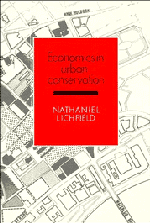Book contents
- Frontmatter
- Contents
- List of diagrams, tables and plans
- Preface
- Acknowledgements
- Introduction
- Part I Planning and management in the conservation of the urban system
- Part II Conservation of the cultural built heritage
- Part III Economics in urban conservation
- Part IV Selected tools of economic analysis for project evaluation
- 13 Financial impact: financial analysis
- 14 Economic impact: social cost benefit analysis
- 15 Community impact: community impact analysis
- Part V Case studies in the economics of conservation of the CBH
- Notes
- Bibliography
- Index
15 - Community impact: community impact analysis
Published online by Cambridge University Press: 10 November 2010
- Frontmatter
- Contents
- List of diagrams, tables and plans
- Preface
- Acknowledgements
- Introduction
- Part I Planning and management in the conservation of the urban system
- Part II Conservation of the cultural built heritage
- Part III Economics in urban conservation
- Part IV Selected tools of economic analysis for project evaluation
- 13 Financial impact: financial analysis
- 14 Economic impact: social cost benefit analysis
- 15 Community impact: community impact analysis
- Part V Case studies in the economics of conservation of the CBH
- Notes
- Bibliography
- Index
Summary
Context
We introduced above (Introductory, 13.3 and 14.2) the term ‘social’ to reflect that financial and economic analysis was concerned in each case with repercussions on sectors other than those who were promoting the project under consideration. But even under this connotation the range of the sectors brought in is only partial. For example in social financial analysis they exclude off-site costs not borne by the promoters; and while social cost benefit analysis is capable of handling the sectors which are indirectly affected, it typically does not set out to do so.
But there are decision situations in which consideration of the impact on the whole community is essential, as in urban and regional planning, where the ‘public interest’ requires that decisions take into account the impact on all relevant sectors of the relevant community. Thus a full analysis is required which will encompass all the off-site linkages and effects which were introduced in Table IV. 1, thus including all relevant externalities and spillovers. Thus a fully social form of analysis is required. This is provided by community impact analysis.
But even if social cost benefit analysis were to attempt to cover the whole range of sectors and externalities involved, it typically has the following limitations. Being founded in economic analysis it tends to have regard primarily to economic impacts and thus ignores others which are relevant, such as social and environmental, which come outside the ‘measuring rod of money’ and are not in the economic content of national income accounts.
- Type
- Chapter
- Information
- Economics in Urban Conservation , pp. 249 - 284Publisher: Cambridge University PressPrint publication year: 1989



